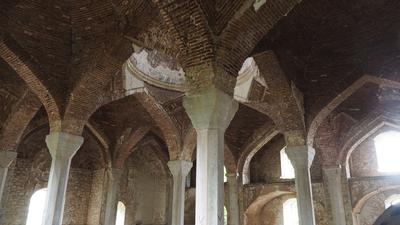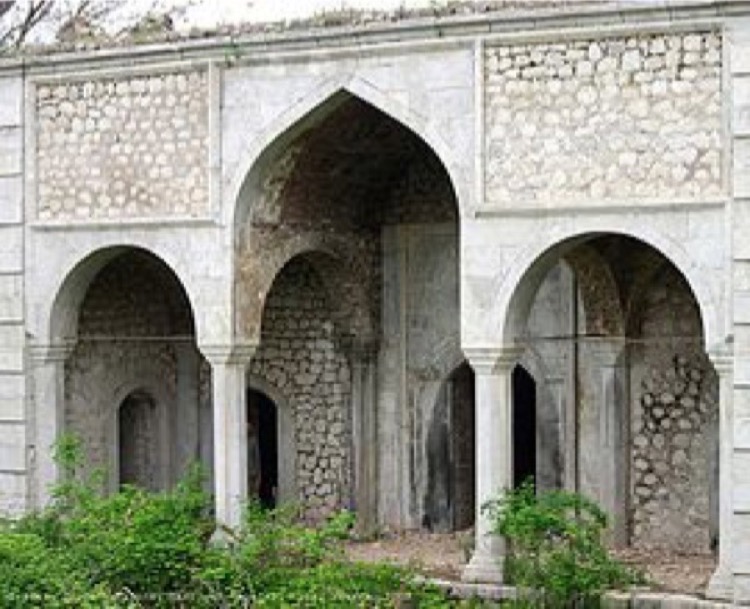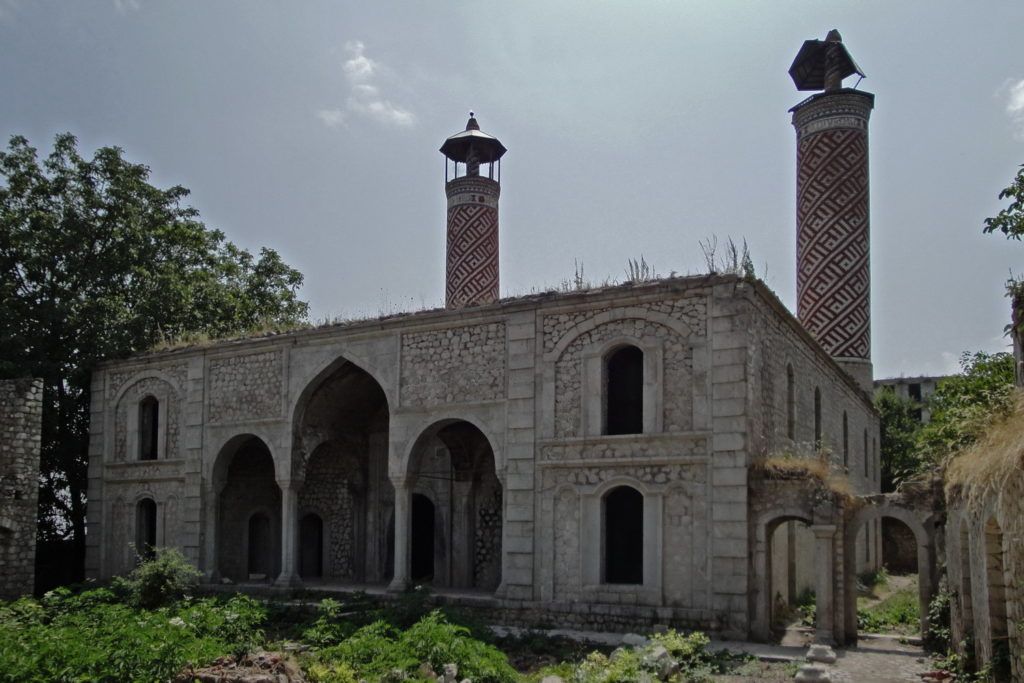Armenian vandalism in Shusha
Ashaghi Govhar Agha Mosque

One of the famous masterpieces of the architect Karbalayi Safikhan Garabaghi in Shusha city is the Ashaghi Govhar Agha Mosque. The name of the Ashaghi Govhar Agha in the Azerbaijani language referring to the location of the Mosque. Thus, the city of Shusha consisted of 17 mahallas (quarter/district/neighborhood) that were divided into upper (yukhari) and lower (ashaghi) mahallas. Ashaghi Govhar Agha Mosque is located in the lower (ashaghi) part of the city; therefore the Mosque was named as it is. It was built in the years 1874-1875 at the expense of Govhar Agha, daughter of the last ruler of Karabakh khanate Ibrahimkhalil khan.[1]
It is possible to say that, the mosques that were built by Karabalayi Safikhan Garabaghi in all mahallas of Shusha city have similarities between each other and one may feel the common architectural style in their construction. In this regard, the Ahaghi Govhar Agha Mosque makes a resemblance with the Aghdam Juma Mosque and the Yukhari Govhar Agha Mosque in terms of its plan and location specifics. However, unlike the first two mosques, the minarets of the former one are located not in the front façade, but at the former of the rear façade.[2]
The Yukhari Govhar Agha and Ashagi Govhar Agha mosques have known as Shusha city’s Juma mosques, which have two hundred meters distance between each other. The main aim of the Govhar Agha for building these two mosques next to each other was creating worshipping conditions for people from two different sects of Islam.
The main façade of the Ashaghi Govhar Agha Mosque has special art architecture. There is a three-arched wide veranda in the entrance of the Mosque. This three-arched symmetric construction has been assembled on two octagonal stone columns located at an equal distance from the center stone and two other pilasters placed in the edges. The arrow-shaped arch assembled in the center is higher than illustrated semicircle arches on the sides. The architect placed quadrangular geometrical figures with light relief lines on both semicircle arches. The same part of the veranda from both sides is limited by vertical figures divided by horizontal lines. A pair of windows with lower and upper parts is located on the right and left side of the veranda and the niches on the sides have been edged in the general picture. Despite these borders being in the right-angled picture, the window and the cover constructions of the niches have been constructed in a semicircle form. Like other living buildings of Shusha, the Mosque roof has a four-slope form.
As it is mentioned above, the architect placed the Ashaghi Govhar Agha Mosque minarets on the sides of the back facade. Investigations show that minarets have not been raised here accidentally. Head facade is limited to the religious school building; on its backside, a wide trade square is located. To make the building more lofty and attractive, the architect placed the minarets in the facade back. The minaret podiums have a direct connection not with the inner, but with the external part of the Mosque; it is a bit higher than the Mosque wall level and is built of natural limestone. The whole cylindrical minaret building has been constructed till the garret with fired bricks. The architect has arrayed the Mosque minaret building with repeated writing of the “Allah” word. These words and special brickwork make up an impressive ornament mixture. The basic entrance of the Ashaghi Govhar Agha Mosque is located on the opposite of two-store religious school building in the yard. The religious school has been encircled with wide verandas from the yard side. The columns of the ground floor veranda were made in octagonal form from natural limestone. The upper part of the columns is connected via half-moon arches. The second-floor veranda columns have been made of pure wood. The distances between the columns of the veranda are connected by rail that maid out of wood.
Thus, due to its unique nature and architectural style the Ashaghi Govhar Agha Mosque was included in the list of the immovable historical and cultural monuments of state significance by resolution of the Cabinet of Ministers of the Republic of Azerbaijan No.132, dated August 2, 2001. Like other historical and religious monuments of Shusha city, the Ashaghi Govhar Agha Mosque also tasted Armenian vandalism. During the occupation of Shusha in May 1992, by the Armenian Armed Forces, the Mosque and its minarets were severely damaged by being exposed to fires of the armored vehicles.[3]
[1] “Shusha Region”, Armenian Vandalism: Azerbaijani Monuments in Captivity. https://www.armenianvandalism.az/en_shusha.html.
[2] Ministry of Culture and Tourism of the Republic of Azerbaijan, Garabakh: The Eternal Memory of Azerbaijan Heritage, (Baku, 2008), p. 23.
[3] “Shusha Region”, Armenian Vandalism: Azerbaijani Monuments in Captivity. https://www.armenianvandalism.az/en_shusha.html.





